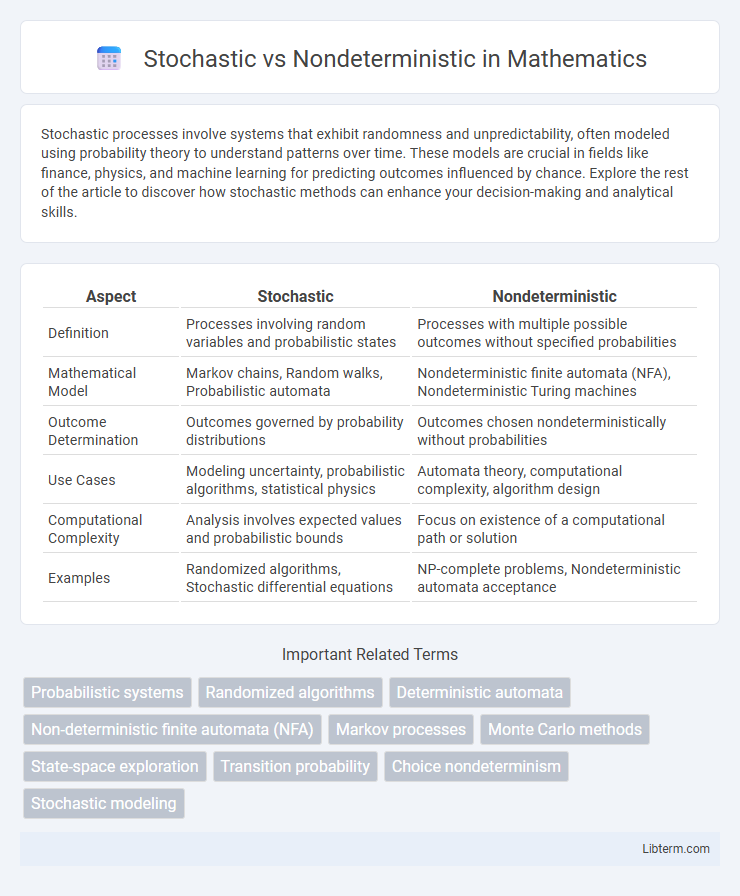Stochastic processes involve systems that exhibit randomness and unpredictability, often modeled using probability theory to understand patterns over time. These models are crucial in fields like finance, physics, and machine learning for predicting outcomes influenced by chance. Explore the rest of the article to discover how stochastic methods can enhance your decision-making and analytical skills.
Table of Comparison
| Aspect | Stochastic | Nondeterministic |
|---|---|---|
| Definition | Processes involving random variables and probabilistic states | Processes with multiple possible outcomes without specified probabilities |
| Mathematical Model | Markov chains, Random walks, Probabilistic automata | Nondeterministic finite automata (NFA), Nondeterministic Turing machines |
| Outcome Determination | Outcomes governed by probability distributions | Outcomes chosen nondeterministically without probabilities |
| Use Cases | Modeling uncertainty, probabilistic algorithms, statistical physics | Automata theory, computational complexity, algorithm design |
| Computational Complexity | Analysis involves expected values and probabilistic bounds | Focus on existence of a computational path or solution |
| Examples | Randomized algorithms, Stochastic differential equations | NP-complete problems, Nondeterministic automata acceptance |
Introduction to Stochastic and Nondeterministic Systems
Stochastic systems are characterized by randomness and probabilistic behavior, where outcomes are influenced by inherent uncertainties and probability distributions. Nondeterministic systems, in contrast, allow multiple possible future states without predefined probabilities, representing all potential behaviors without a specific likelihood. Understanding these fundamental differences is crucial for modeling complex processes in fields like computer science, operations research, and artificial intelligence.
Definitions: What is Stochastic?
Stochastic refers to systems or processes that involve randomness or probabilistic behavior, where outcomes are determined by inherent random variables and probability distributions. In contrast to deterministic models, stochastic models incorporate uncertainty, producing different results even under identical initial conditions. These concepts are crucial in fields such as statistics, physics, and artificial intelligence for modeling real-world phenomena with inherent unpredictability.
Definitions: What is Nondeterministic?
Nondeterministic systems describe processes where multiple possible outcomes can occur from a given state without a defined probability distribution, often used in theoretical computer science and automata theory to model decision points with various possible transitions. Unlike stochastic models, nondeterminism does not assign likelihoods to transitions, focusing instead on the existence of one or more feasible paths or states. This concept is fundamental in nondeterministic finite automata, where a single input may lead to several possible next states, emphasizing the ambiguity of computational steps rather than randomness.
Key Differences Between Stochastic and Nondeterministic Models
Stochastic models incorporate randomness by using probabilistic transitions to represent uncertainty in system behavior, whereas nondeterministic models allow multiple possible outcomes without specifying probabilities. The key difference lies in stochastic models quantifying likelihoods of events through probability distributions, while nondeterministic models focus on all possible evolutions without probabilistic measures. This distinction impacts their applications, with stochastic models suited for scenarios requiring probabilistic predictions and nondeterministic models used for analyzing all potential system behaviors without probability assignments.
Applications of Stochastic Processes
Stochastic processes are widely applied in fields such as finance for modeling stock prices, in telecommunications for analyzing network traffic, and in biology for understanding population dynamics. These processes incorporate randomness, making them ideal for predicting systems influenced by probabilistic events. In contrast, nondeterministic models, often used in theoretical computer science and automata theory, focus on multiple possible outcomes without inherent probability distributions.
Applications of Nondeterministic Systems
Nondeterministic systems are widely used in computational theory for modeling concurrent processes and automata, enabling efficient problem-solving in language recognition and artificial intelligence. They play a crucial role in designing algorithms for parallel computing, where multiple possible execution paths are explored simultaneously to optimize performance. Applications also extend to network protocols and cryptography, where nondeterminism helps in handling unpredictable environments and enhancing security.
Mathematical Foundations and Theories
Stochastic models incorporate randomness through probabilistic transitions governed by probability distributions, enabling the analysis of systems with inherent uncertainty via tools such as Markov chains and stochastic processes. Nondeterministic frameworks, rooted in automata theory and formal languages, represent multiple possible system behaviors without assigned probabilities, often used to explore computational complexity and verification problems. Mathematical foundations of stochastic systems rely on measure theory and probability spaces, whereas nondeterministic theories are based on set theory and logic, differentiating their application in algorithm design and theoretical computer science.
Examples in Computing and Engineering
Stochastic systems involve randomness and probabilistic behavior, such as Monte Carlo simulations used in computational physics to model particle interactions, whereas nondeterministic systems feature multiple possible outcomes without probabilistic weighting, exemplified by nondeterministic finite automata in computer science that accept input strings through various computation paths. In engineering, stochastic models appear in reliability testing and signal processing with noise, while nondeterministic approaches are utilized in control systems design to account for uncertainties in system responses without explicit probability distributions. These distinctions guide the choice of algorithms and modeling techniques in optimizing system performance under uncertainty.
Advantages and Limitations of Each Approach
Stochastic models excel in handling uncertainty through probabilistic transitions, enabling precise quantification of likelihoods in complex systems, but they require extensive data and computational resources for accurate parameter estimation. Nondeterministic models offer simplicity and ease of analysis by abstracting decision points without probabilistic detail, making them suitable for verifying broad system properties yet lack the ability to represent probabilistic behaviors accurately. The trade-off between stochastic and nondeterministic approaches lies in balancing detailed probabilistic modeling with computational tractability and the level of uncertainty representation needed for the application.
Choosing Between Stochastic and Nondeterministic: Factors to Consider
Choosing between stochastic and nondeterministic models depends on the nature of uncertainty in the system being analyzed. Stochastic models are ideal when probabilities of different outcomes are known or can be estimated, allowing for precise quantitative predictions based on randomness. Nondeterministic models suit scenarios where uncertainty derives from incomplete information or multiple possible transitions without assigned probabilities, emphasizing structural exploration over probabilistic analysis.
Stochastic Infographic

 libterm.com
libterm.com